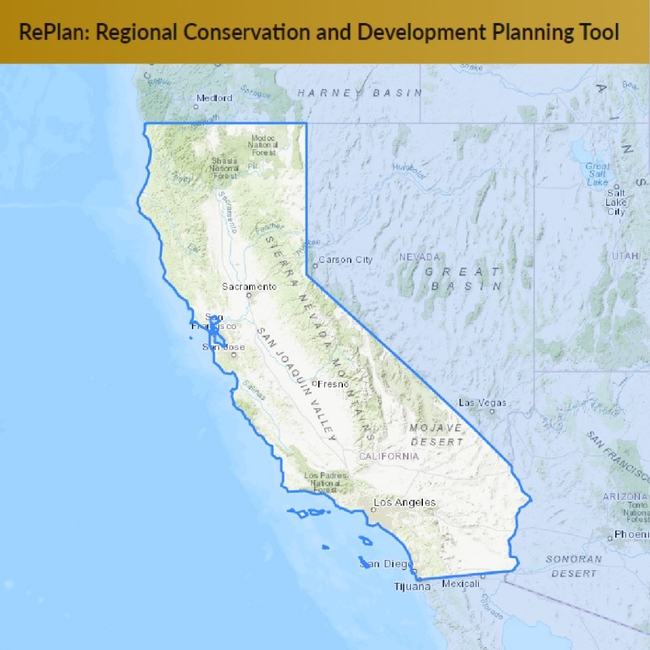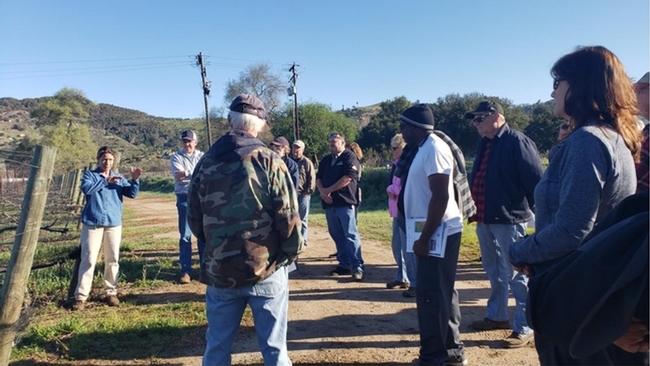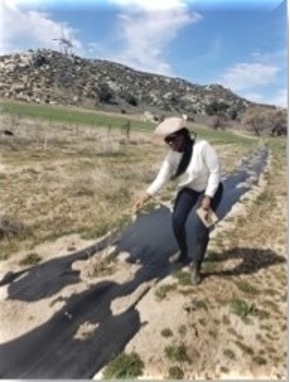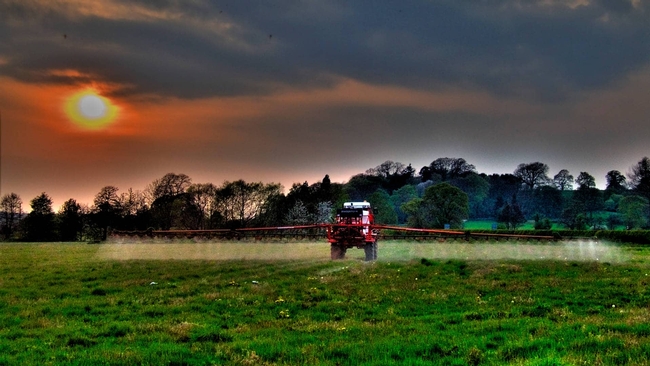
Posts Tagged: climate
Climate Action Symposium
May25,2023
9:00AM–4:00PM|FREE:RegistrationRequired
D E A D L I N E – M A Y 18 , 20 2 3
San Diego County Farm Bureau- Farm Hub Conference Room 420 S Broadway, Escondido, CA 92025
The development of policies, programs, strategies and resources to support sustainable agriculture throughout Southern
California is contingent on understanding changing climate and its impact to the unique agricultural environments and industry in the region. This symposium is intended to bring together policy makers, government agencies, researchers, educators, consultants and other public and private agricultural service providers.
Join us at this 5th annual event exploring the situational status of climate and agriculture in the San Diego County region. There will be a variety of perspectives shared and information on research findings, resources and regenerative farming opportunities and challenges.
TOPICS AND SPEAKERS INCLUDE:
Perspectives in Agriculture and Farming inDiego County
Mary Matava (Farm Bureau/AgriService, Inc.) and
Maria Gomez (County Dept. of Agriculture, Weights and Measures)
Climate Impact on Agriculture and UC ANR Research and Resources
Dr. Tapan Pathak (UC Divison of Agriculture and Natural Resources Division)
Regional Climate Trends and Weather Prediction
Dr. Tom Corringham (UC San Diego)
Life Cycle of Greenhouse Gas Emissions and Energy Use in Orchard Crops
Elias Marvinney (UC Davis)
Advances in Sustainable Agriculture Policy and Programs
County of San Diego Sustainability Division
Regenerative Organic Agriculture Opportunities and Challenges
Elizabeth Whitlow (Regenerative Organic Alliance), Ramiro Lobo (UCCE), Eric Morgan (Braga Fresh) and
Bea Alvarez (FoodshedSanDiego).
… and More! Visit the event website for complete Agenda and Speaker details.
For More Information:
C O N T I N U I N G E D U C A T I ON
- Certified Crop Advisor: applying for 6 hours in ‘Sustainability' category
Jan Gonzales, Email: jggonzales@ucanr.edu
Funding support for this event provided by the County of San Diego.
UC ANR is an equal opportunity provider and employer.

CAAS 2023 Flyer (Final)
Applying for Climate Smart Funding - Fast
|
Office of Public Affairs posted: " A new tool designed to provide farmers and ranchers with essential information about applications for climate smart agriculture programs is now available online. the tool features a user-friendly map for users to explore, screen and efficiently ident" |
Application Process for Climate Smart Ag Programs
A new tool designed to provide farmers and ranchers with essential information about applications for climate smart agriculture programs is now available online. the tool features a user-friendly map for users to explore, screen and efficiently identify regions for analysis, comparison and reporting. The intent is to place this information at the fingertips of farmers and ranchers, making the application process faster, and more efficient. The web-based tool, named RePlan (Regional Conservation and Development Planning Tool), comes as a result of a partnership between the California Department of Food and Agriculture (CDFA), the Governor's Office of Planning and Research (OPR), and the Conservation Biology Institute (CBI). RePlan developers have created applications for two CDFA programs -- the Healthy Soils Program (HSP) and the Alternative Manure Management Program (AMMP). For HSP, RePlan combines site location technology and environmental datasets in a user-friendly website to assist applicants in determining eligible individual innovation soil management practices as well as the compatibility of multiple practices. For AMMP, the tool combines relevant datasets with site location and analysis tools to identify practices that will reduce dairy and livestock methane emissions through the implementation of non-digester approaches. In one step, a farmer can model current and proposed practices, explore alternative practices, calculate the resulting emission reductions using California Air Resources Board tools, and submit a final proposal package for AMMP funding. The Partners The California Strategic Growth Council (SGC) collaborates with public agencies, communities, and stakeholders to achieve sustainability, equity, economic prosperity, and quality of life for all. SGC also manages several grant programs funded by the California Climate Investments (CCI) that aim to reduce greenhouse gas emissions while providing also providing a variety of other benefits - particularly in disadvantaged communities. The Governor's Office of Planning and Research (OPR) studies future research and planning needs, fosters goal-driven collaboration, and provides guidance to state partners and local communities, with a focus on land use and community development, climate risk and resilience, and high-road economic development. The Conservation Biology Institute (CBI) applies the best science and technology available to accelerate the conservation, recovery, and adaptation of biological diversity in a fast-changing world. Their expertise includes GIS and decision-support tools, global forest conservation, landscape modeling, water, energy, and infrastructure development. CBI created Data Basin in response to the increased demand for geographic environmental and conservation data access, integration, interpretation, analysis, and sharing. |
https://plantingseedsblog.cdfa.ca.gov/wordpress/wp-content/uploads/2022/04/RePlan-Blog-Image.png
https://plantingseedsblog.cdfa.ca.gov/wordpress
Climate Change: What does it mean for Southern California?
Last month, the Thelma Hansen Fund hosted a three-day series to inform about climate change and the science behind it. In an effort to raise awareness of current and predicted impacts on Southern California, the impressive line up of UC...
Healthy Soils and Smart Agriculture
- Contributor: Kristian M Salgado
- Contributor: Emily Lovell
- Contributor: Caddie Bergren
- Contributor: Nicki Anderson
- Contributor: Shulamit Shroder
- Contributor: Samikshya Budhathoki
- Contributor: Esther Mosase
- Contributor: Valerie Perez
UC ANR Climate Smart Agriculture Educator team assisted growers to win CDFA grants that reduced greenhouse gases equivalent to removing roughly 7,000 cars off the road, supporting UC ANR's public value of building climate-resilient communities and ecosystems.
The Issue
Increasingly extreme and erratic weather patterns caused by climate change threaten crop yields and farm profits across the state. Growers must continue to adapt to climate stressors, such as increased temperatures and occurrences of drought, and can aid in reducing climate change through their farming practices.
How UC Delivers
A collaborative partnership between the Strategic Growth Council, California Department of Food and Agriculture (CDFA), and University of California Agriculture and Natural Resources (UC ANR) teamed up to support 10 Climate Smart Agriculture Community Education Specialists (CSA CES) throughout the state to provide technical assistance and outreach to promote Climate-Smart Agriculture Incentive Programs. These programs include:
- The Healthy Soils Program, which incentivizes the implementation of climate-smart agriculture practices such as cover cropping, composting, crop rotation, and mulching which reduce erosion and greenhouse gases
- The State Water Efficiency and Enhancement Program (SWEEP), which encourages farmers to install more efficient irrigation systems that decrease water consumption and greenhouse gas (GHG) emissions; and
- The Alternative Manure Management Program (AMMP), which awards funds to livestock producers who decrease their methane emissions by changing the way they manage manure.
Since establishing this partnership in 2019, the UC ANR Climate Smart Agriculture Educator team has provided hands-on assistance to over 200 farmers and ranchers through the complex application process. Collaborating with other CDFA technical providers to host workshops, field days, and events has expanded reach to a greater number of growers, over 120 of whom were able to receive funding after receiving technical assistance. UC CSA CES efforts don't stop at the outreach or application phase; educators work year-round to ensure successful implementation of climate-smart projects.
After the award process, educators assist awardees in completing grant invoicing and contract reporting requirements and connect them with vendors, industry experts, and service providers. UC CSA CES also engage in a variety of additional support activities. For example, to help establish successful cover crop adoption, one educator created a cover crop decision-making tool. A different educator started a small compost spreader rental program to assist small growers in spreading compost. Another facilitates full project management through translation services to a cooperative of Cantonese-speaking awardees.
The Impact
Through assisting awardees in the adoption of practices such as cover cropping, installing solar panels, and installing dairy manure solid separator systems, the 10 UC CSA CES have collectively supported growers in reducing 33,000 MT/CO2 per year, as measured by California Air and Resources Board (CARB) Green House Gas Emission reduction calculator (SWEEP GHG Calculator on CDFA's website), and the HSP Comet planner tool. That's equivalent to removing 7,000 cars from the road per year.
Table A provides an overview of how much GHG has reduced in counties where the UC Climate Smart Agriculture Educator team has helped farmers implement climate-smart practices. Totals for all projects are much higher.
|
UCCE-County Location |
Total CO2 equivalent in MT/year |
|
Sonoma, Mendocino, and Lake County |
314.2 |
|
Merced, Madera, Stanislaus |
5263.31 |
|
Glenn, Butte, Colusa, Tehama County |
4545.785 |
|
Yolo, Solano, Sacramento, San Joaquin, El Dorado, Sonoma, Colusa, Sutter |
11716.4 |
|
Santa Clara County |
58.85 |
|
Fresno County |
1353.924 |
|
Kern & Tulare Counties |
7060.283 |
|
Santa Barbara, Los Angeles, Orange, Ventura County |
630.5 |
|
San Diego and Riverside Counties |
300.18 |
|
Imperial County and Riverside County |
3689.1 |
Glenn County grower, Shannon Douglass says, “When producers have the support from the UCCE office that they already know and trust, they are more willing to implement new practices. The application process is intimidating, but with the help from UC, soil healthy practices are becoming much more widely adopted.”
Research shows that Healthy Soils Program practices such as compost application increases the amount of organic matter in soil, amongst numerous other benefits such as increasing the water and nutrient retention capacity of soils, providing a reservoir of nutrients for plants, improving aeration, improving water infiltration, reducing soil erosion, and supporting the abundance and diversity of soil organisms, which can improve plant health. Compost application is just one fundable practice farmers can implement to help reduce greenhouse gases on their operation.
Thanks to this unique partnership with CDFA, UC ANR is able to provide hands-on support to farmers statewide so that they can improve the health of their soils, reduce livestock methane emissions, and improve water use efficiency. In this way, the Climate-Smart Agriculture program contributes to UC ANR's public value of building climate-resilient communities and ecosystems.

bell bean
Changing Temperatures Affecting Herbicide Efficacy?
Will Rising Temperatures Make Superweeds Even Stronger?
Widely used herbicides are struggling to kill some weeds. Some experts think heat could be part of the problem.
From the digital magazine, Undark • Dec. 7, 2020
By Natasha Gilbert • 12.07.2020
Around 10 years ago, in the fierce heat of the Kansas summer, many of the noxious kochia weeds invading Phillip Stahlman's research fields simply wouldn't budge when sprayed with a mixture of two widely used herbicides, glyphosate and dicamba. Just a few months earlier, in the cooler spring weather, the herbicide mixture had easily triggered the weed's small thin leaves to curl up and turn brown, signaling the plant's demise.
Now the stalwart weed had Stahlman stumped. Stahlman, then a weed scientist at Kansas State University, had never encountered this problem with herbicides before. He initially assumed that he had applied the agrichemicals incorrectly. But year after year, the same thing happened. Stahlman knew something was up. He kept a close watch on the weeds in his fields. He also conferred with local farmers who reported seeing similar problems. “The light didn't come on for a while until the issue kept reoccurring. It was like putting together a puzzle,” says Stahlman.
Eventually, Stahlman, who has since retired, decided that the problem was likely temperature: Something about spraying in high heat was rendering the herbicides less effective.
Stahlman is not alone in making this observation. Today, mounting evidence suggests that temperatures of around 90 degrees Fahrenheit or above can make some herbicide-resistant weeds even more resistant, and cause other weeds to be less sensitive to certain chemicals.
Some farmers say they know high temperatures can mess with some herbicides, so they try to avoid spraying in the heat of the day. “A good rule of thumb is if it's 85 to 90 degrees Fahrenheit, just don't spray,” says Curt Gottschalk, a farm manager in Hays, Kansas.
Not all experts agree that this pattern, largely demonstrated in lab experiments, poses a problem for farmers. And some herbicides appear to work even better at high temperatures. But if heat is boosting many weeds' resistance to major herbicides, the implications could be significant. Left unchecked, weeds can devastate harvests and income — if farmers didn't make an effort to control weeds, they could wipe out around half of all corn and soybean yields across the U.S and Canada, according to the Weed Science Society of America, a nonprofit society of academic and industry scientists. The loss could cost farmers around $43 billion annually.
Farmers are already battling against epidemics of weeds that have developed genetic resistance to multiple herbicides, including glyphosate and dicamba. Stahlman and other weed researchers argue that temperature could be an overlooked second factor strengthening weeds' defenses against herbicides. Although most farmers now understand that temperature affects herbicides, to the untrained eye it could look just like herbicide resistance, Stahlman says.
These researchers also fear the issue could worsen in the future as climate change raises temperatures and extreme weather events, including heat waves, become more frequent.
“We already know that herbicide resistance is the most problematic issue in chemical weed control,” Maor Matzrafi, a weed scientist at Israel's national Agricultural Research Organization, wrote in an email to Undark. “Maybe reduced sensitivity due to climate change is next in line.”
Farmers used to rely less on herbicides, instead controlling weeds using laborious methods such as tilling and manual removal. But, starting in the mid-1990s, biotechnology companies began debuting genetically modified crops that were resistant to common, powerful herbicides. The new seeds allowed farmers to liberally spray their fields with agrochemicals to kill weeds while their GM crop flourished. The technology made most manual weeding unnecessary, and herbicide use surged globally. But weeds evolved in response, and herbicide resistant varieties emerged. That has set off a new battle between farmers and weeds, with farmers increasingly using combinations of chemicals, as well as additional doses, to try to knock off weeds.
After Stahlman's experience with kochia weeds, though, he began to examine whether temperature could be affecting herbicide performance more than was widely recognized. (Stahlman, like many academic weed scientists, has received research funding from agrochemical companies in the past.)
To decipher how heat helps weeds fend off herbicides, Stahlman teamed up with KSU colleagues Mithila Jugulam, a weed physiologist, and Junjun Ou, a research assistant. The team grew seedlings from kochia populations that originated in Kansas, in chambers kept at temperatures ranging from 63.5 to 90.5 degrees Fahrenheit — representative of the state's spring and summer daytime heat. The temperature in the chambers dropped every 12 hours to mimic cooler nighttimes. When the seedlings reached around 4 inches high, the researchers dosed some with glyphosate and others with dicamba. At weekly intervals, the team examined the weeds for signs of injury. After one month, they cut down the weeds and dried and weighed them.
The team found that, at high temperatures, they needed more than twice the amount of glyphosate and dicamba to control weeds. They published their results in 2016.
“A good rule of thumb is if it's 85 to 90 degrees Fahrenheit, just don't spray,” says Curt Gottschalk, a farm manager in Hays, Kansas.
To understand why heat reduced sensitivity, the researchers tracked the herbicides' paths through the weeds using mildly radioactive versions of glyphosate and dicamba. The former previously manufactured by Monsanto, and the latter produced by BASF Corp. (BASF Corp. provided a graduate student assistantship to Ou for a different project.)
The team found that the leaves absorbed less glyphosate at higher temperatures. They're not sure why, but Jugulam thinks the heat may encourage the kochia to develop thicker cuticles — a protective layer on the leaf surface — which then boost the weeds' defenses against the herbicide. The team discovered a different process at work when the weeds encountered dicamba. Temperature did not affect the amount of dicamba that the weeds' absorbed, but it did hinder the herbicide's movement through the plant so that less reached its target — the tissue developing at the tips of new shoots and leaves.
In another study, published last year, Jugulam turned her attention to the herbicide 2,4-D, one of the ingredients of agent orange, an infamous defoliant used in the Vietnam War. Today, it's one of the most widely used herbicides. Jugulam tested how temperature affected the herbicide's ability to control common waterhemp, a broadleaf weed found encroaching on Midwestern corn and soybean fields.
In the tests, Jugulam examined some common waterhemp that had developed genetic resistance to 2,4-D, and some that had not. She found that it took more than three time as much herbicide to kill the resistant weed under hot, dry conditions than at cooler temperatures. She found a similar but smaller effect in the susceptible weeds.
Herbicide-resistant waterhemp survives exposure to 2,4-D by quickly breaking the chemical down into nontoxic substances before it can reach its targets at the tips of roots, stems, and leaves. When the temperature is high, Jugulam found, waterhemp breaks down those molecules faster.
Jugulam also noted that under high temperatures, some herbicide resistant weeds appear to become more resistant and some susceptible weeds may require more herbicide for their control.
Not all weeds and herbicides respond to temperature the same way. For example, Jugulam has also found that 2,4-D and glyphosate work better at higher temperatures against common and giant ragweed, two other weeds common in U.S. farmers' fields. Jugulam also says that, even in cases where heat does hinder herbicides, the impacts appear to be mostly limited to dry conditions. Areas with high humidity and rainfall might not see the same effects.
But some experts say evidence is growing in a variety of species and agrochemicals that temperature, and in some cases high carbon dioxide levels, affect weed control, at least in the laboratory.
In tests published in 2016, Matzrafi found that at high temperatures four different species of grass weeds stood up against diclofop-methyl, an ingredient in an herbicide manufactured by Bayer, significantly better than they did at lower temperatures. Matzrafi also found that high temperatures made another herbicide, pinoxaden, less able to curb growth of the invasive grass false brome. Moreover, the grass thrived even when it was switched from cooler conditions to a hotter environment up to two days after the herbicide treatment.(The research was partially funded by ADAMA Agricultural Solutions, an agrochemical company based in Israel.)
“Our findings, and many other studies since the ‘90s, suggest that post-application environmental conditions may also affect herbicide sensitivity,” explained Matzrafi in an email. Even if farmers spray during cooler temperatures, that might not be enough to avoid the effects of heat.

Those conditions, experts fear, will worsen under climate change. Already, many U.S. states important for agriculture, as well as other major food producing regions around the world, regularly experience temperatures topping 90 degrees Fahrenheit during growing seasons. Some researchers say that problems with heat and herbicide performance are coming to the fore now partly because of more frequent episodes of extreme heat over the past few decades.
However, it is hard to pin the effects seen today on recent climatic changes, Lewis Ziska, a plant physiologist at Columbia University in New York, wrote in an email to Undark. But, noting that weeds are “the greatest constraint for food production,” Ziska warns that “they will be a formidable challenge for farmers in a more extreme environment.”
In the Midwest, for example, temperatures could rise by an average of 8.5 degrees Fahrenheit by the end of the century, with longer and more frequent stretches of extreme heat, according to federal government projections. And in South Asia, including India — a globally important region for producing rice, pulses, nuts, and cotton — the Intergovernmental Panel on Climate Change projects that average annual temperatures will rise by nearly 6 degrees Fahrenheit by 2100.
In the first experiment of its kind, the results of which were reported last year, Matzrafi studied the joint effect of heat and raised carbon dioxide levels on two different weed species and found that the combination boosts weeds' herbicide defenses beyond that by either factor alone.
It's not clear whether herbicide manufacturers are prepared for the coming challenges of a warming planet. Many do not recommend optimal spraying temperatures to ensure efficacy in the guidelines they distribute to farmers.
In a written statement Clark Ouzts, a spokesperson for Sygenta, the manufacturer of pinoxaden, says the company has not studied the potential effects of climate change on the herbicide's activity, but that “field research and commercial applications have not shown temperature to have a significant impact on the activity of Pinoxaden.”
Charla Lord, a spokesperson for Bayer, wrote in a statement that the company's herbicides are “extensively tested to meet all regulators' requirements” and “labeled so applicators know how to apply for them for optimal control and success.” The company did not respond to specific questions regarding the efficacy of their products under high temperatures, although the company has posted about the challenges of high-temperature spraying on its website.
Corteva, which makes herbicides incorporating 2,4-D, did not respond to requests for comment on how high temperatures affect the herbicide's performance.
Not everyone is convinced that these experimental findings spell trouble for farmers. Some researchers and weed experts say that laboratory conditions differ radically from the field, making the results less pertinent. “I don't think we could say for sure that this is having an impact at the real-world scale,” wrote Brad Hanson, a weed expert at the University of California, Davis, in an email to Undark. Hanson worked with Matzrafi on the research published last year.
Hanson, who works with California farmers as a researcher and extension specialist, also wrote that farmers typically use enough herbicide to overcome any small changes in weed sensitivity brought on by heat.
Kassim Al-Khatib, a crop physiologist at the University of California, Davis who has investigated how herbicides perform under heat and humidity, wrote in an email to Undark that the studies are carried out under carefully controlled laboratory conditions that farmers would never find in their fields.
“What happens under controlled conditions does not generally support what happens in field conditions,” he wrote.
It's not clear whether herbicide manufacturers are prepared for the coming challenges of a warming planet.
In his own research, Al-Khatib has studied the effect of temperature and humidity on a small number of herbicide types and weed species. In the cases he has studied, he says, herbicide efficacy generally improves at higher temperature and humidity, unless temperatures exceed 100 degrees Fahrenheit.
Matzrafi and Jugulam agree that the lab does not reflect the more complex farm environment.
“But I don't think it lessens the importance of the results,” Matzrafi wrote. He, Stahlman, and others say they have seen the effect in the field for themselves.
“I think we are seeing something. Over the next 10 years I think we will see more. It's going to be a major problem,” says Chuck Otte, a K-State Research and Extension agent in Geary County, Kansas, who primarily works with farmers.
The research findings are trying news for farmers who rely on herbicides to keep increasingly weaponized weeds at bay. For now, some farmers are striving to stave off some of the effects from heat by spraying herbicides during cooler periods of the day. In the heart of summer, Carie Moore says she sometimes wakes before dawn to spray her 650-acre farm in North Dakota before the heat climbs too high, occasionally topping 100 degrees Fahrenheit. But as the globe warms, farmers will face narrower windows during which temperatures are cool enough to spray, says Ziska. And Matzrafi's research suggests that spraying during cooler periods doesn't guarantee that herbicide efficacy isn't affected by bursts of heat that come later in the day or even the following day.
And sometimes farmers can't avoid spraying herbicides in the heat, particularly on huge farms with several thousand acres.
Otte says that skeptics might not realize their herbicides are not working because heat has given weeds a helping hand. They might first assume that an array of other common factors are at fault, such as herbicide resistance, lack of rainfall, or too little herbicide. “There are so many confounding factors it is difficult to sort it all out,” he says.
In the long-run, farmers will need to lessen their reliance on herbicides and instead use other techniques more often used in organic farming today to keep weeds at bay, many experts say. For example, planting cover crops such as spring oats or crimson clover helps stop weeds taking root in bare soil and growing a variety of crops in rotation can wrong-foot weeds helping to suppress populations. Moore is already moving in this direction. She rotates soybeans with wheat, barley, and a couple of other crops and plants a variety of additional cover crops including rye and peas.
She also occasionally tills the soil to help stifle weed growth. “The less we have to spray chemicals the better,” she says.
Yet, to keep up yields, farming can't entirely abandon herbicides, says Ziska. With very few new chemicals on offer, farmers will need to be more careful with the herbicides they have now to ensure they continue to work in the future. Manufacturers need to provide farmers with better advice on when and how to use herbicides, adds Matzrafi.
“Farmers can no longer just spray and pray,” says Otte.
***
Natasha Gilbert is a freelance reporter in Washington, D.C., who has spent over a decade covering the environment, agriculture, and sustainability.
Original source: Undark • Dec. 7, 2020
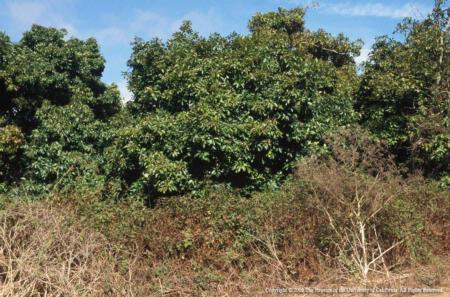
weeds bordering avocado orchard

